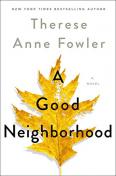BKMT READING GUIDES
A Good Neighborhood
by Therese Anne Fowler
Paperback : 336 pages
51 clubs reading this now
7 members have read this book
Introduction
In Oak Knoll, a verdant, tight-knit North Carolina neighborhood, professor of forestry and ecology Valerie Alston-Holt is raising her bright and talented biracial son, Xavier, whoâ??s headed to college in the fall. All is well until the Whitmansâ??a family with new money and a secretly troubled teenage daughterâ??raze the house and trees next door to build themselves a showplace.
With little in common except a property line, these two families quickly find themselves at odds: first, over an historic oak tree in Valerie's yard, and soon after, the blossoming romance between their two teenagers.
Editorial Review
No Editorial Review Currently AvailableExcerpt
1An upscale new house in a simple old neighborhood. A girl on a chaise beside a swimming pool, who wants to be left alone. We begin our story here, in the minutes before the small event that will change everything. A Sunday afternoon in May when our neighborhood is still maintaining its tenuous peace, a loose balance between old and new, us and them. Later this summer when the funeral takes place, the media will speculate boldly about whoâ??s to blame. Theyâ??ll chal- lenge attendees to say on-camera whose side theyâ??re on. ...
Discussion Questions
1. Race can be a sensitive topic, and it features prominently inA Good Neighborhood. How comfortable do you feel talking
about race, and do you think this novel changed your
perspective on the role that race plays in the United States?
2. Of her new neighbors, Valerie acknowledges: “I basically
judged them from the second the chain saws started, and
that bothers me. I try to give everyone a chance, or how can
I complain when people pre-judge me?” (pg. 25). What
assumptions do these two families make about each other?
Which of these assumptions do you consider to be racist or
classist?
3. The "Greek chorus" narrative style makes the reader a part of
the story, and complicit in the action. How did that affect
your reading? Who did you believe the “we” was in the book’s
narration?
4. “How many nights in the past few years had Valerie waited
up for her son, praying that he and his friends not be stopped
by the police?” (pg. 17). In what ways are both Juniper and
Xavier taught to protect themselves? How do each of them
handle the sociocultural limitations that are put on their
bodies?
5. Early in the novel, Juniper considers: “What, she wondered,
made a neighborhood good? To her parents, good seemed to
mean there were mainly other people like themselves”
(pg. 50). What do you think makes a “good” neighborhood,
and is Oak Knoll one of them? As new houses are built in
older, existing neighborhoods, do you think that changes the
feel and culture of a place?
Book Club Recommendations
Recommended to book clubs by 2 of 3 members.
Book Club HQ to over 88,000+ book clubs and ready to welcome yours.
Get free weekly updates on top club picks, book giveaways, author events and more








